
WWDC: How The Newest Technology Will Impact Software Development
Written by Pete Nystrom
This year’s WWDC shook the technology landscape once more. As the name implies, the WWDC (Worldwide Developers Conference) is true to its name and placed its focus solely on the developer aspects of the Apple ecosystem. This year’s edition was very different. We witnessed exciting, new mobile software enhancements and the introduction of a completely new operating system which will change the course of software development for years to come.
Biggest Announcements
From a development perspective, the changes announced were mostly regarding API and SDKs, but the most interesting announcement was the introduction of Apple Silicon. Apple announced that they will release their own CPU, Apple Silicon, on all devices by the end of the year and they expect the transition period to be two years.
Apple is parting ways with their partners, Intel and AMD, as main suppliers for CPU and GPU components which were used in all desktop and laptop products. Apple showed off its first Mac product running the same advanced technology that powers the iPad Pro. This change is significant enough that after 12 years, Apple increased the main version number of macOS from 10 to 11 indicating a true change at the core of the operating system.
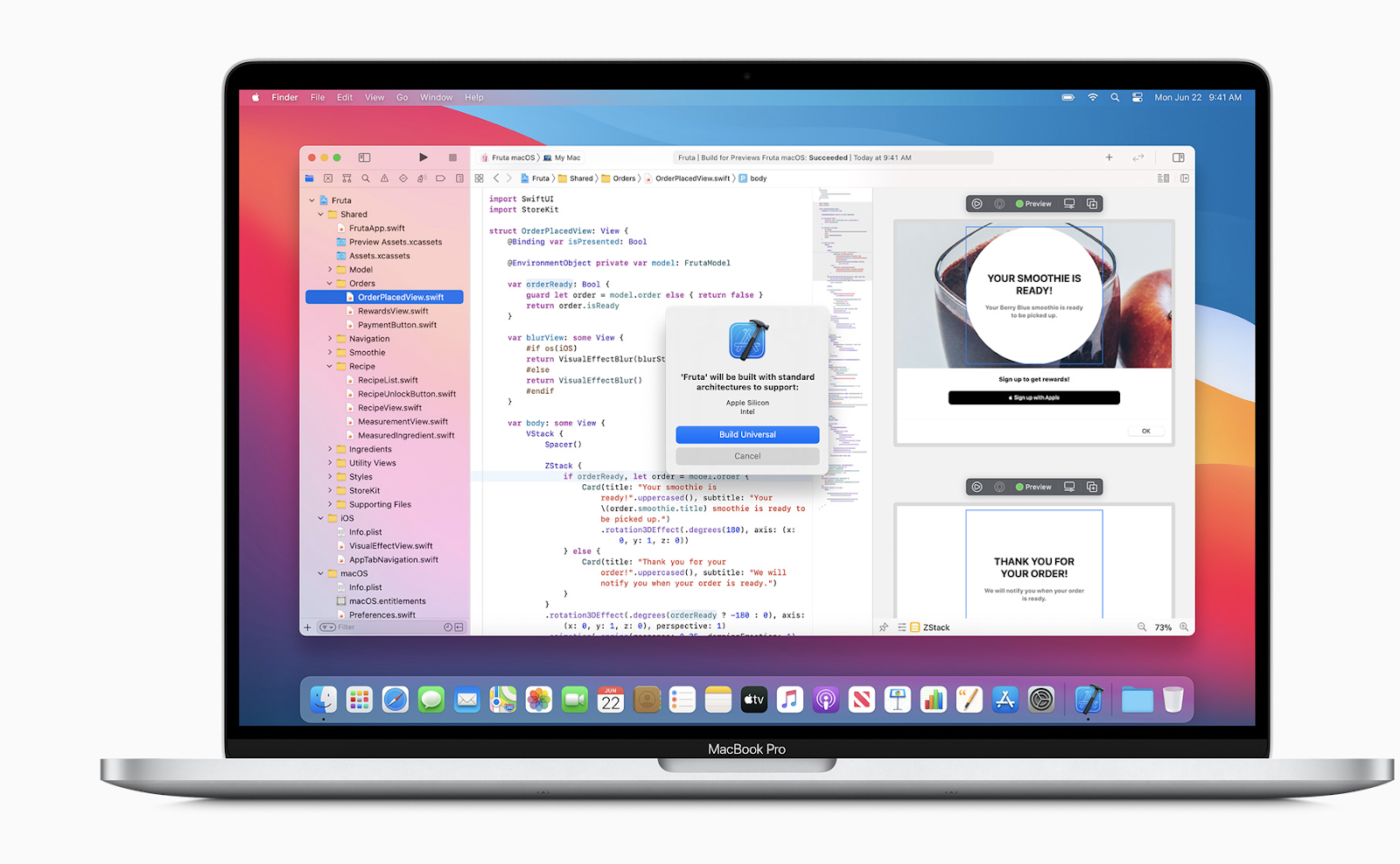
In this image released by Apple, the developer can get a feel for what it will be like to design apps across platforms.
Image credit: Apple
Apple Silicon
Apple Silicon is bound to change the software development process significantly. This new CPU will create a common architecture across all platforms, making it easier to design and develop applications intended for any Apple product (i.e. iPhone, iPad, Mac, etc.) without modifications.
A common architecture across all platforms translates into reduced development hours, which corresponds to the size of the investment required. Businesses can invest in designing and developing a single application and use it across multiple platforms, while delivering the same user experience. Picture yourself accessing a mobile or tablet application on your desktop. Convenient right!? Teams will save time and money with the help of Apple Silicon.
To combat uncertainty of the new platform and to provide developers with a way to adapt to these new changes, Apple is releasing the Universal App Quick Start Program. This program will provide access to documentation, forums, support, and beta versions of macOS Big Sur and Xcode12, as well as a Developer Transition Kit. These resources provide the developer with a chance to experience and plan for the future of Apple. It is highly recommended to take advantage of these resources as soon as possible, as some have limited access.
MacOS Big Sur
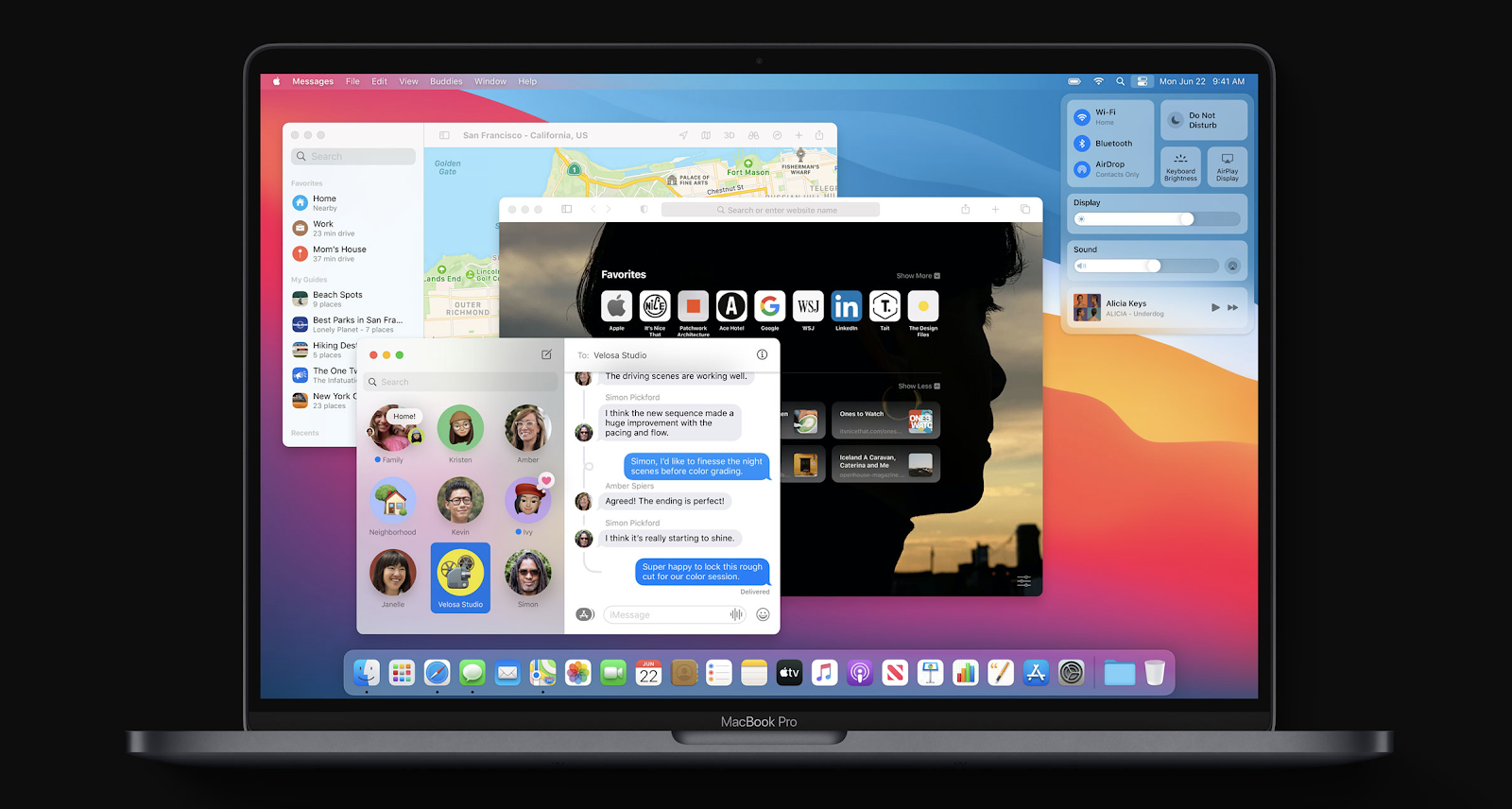
In the image released at WWDC, some of the new features of MacOS Big Sur were revealed visually.
Image credit: Apple
MacOS Big Sur is expected to be released in the Fall. This new software update will lay the foundation for developers to make a seamless transition to Apple Silicon. In Xcode 12, developers are provided with native compilers, editors, and debuggers. According to Apple, most developers will be able to get their apps running in a matter of days with the help of Xcode 12.
In addition to graphic design changes, this new OS attempts to make mobile and iPad apps more accessible on the laptop. The ability to access mobile or tablet applications on the laptop may lead to a change in consumer preferences. Users may find out that they prefer to interact with a mobile app on their laptop. If the laptop arises as a preferred platform, a new question is posed: will web apps still be valuable? For Macs, it is safe to say that web apps will become considerably less valuable since developers are able to make iOS and iPadOS apps available on Macs without any modifications according to Apple. That’s some serious time and cost savings!
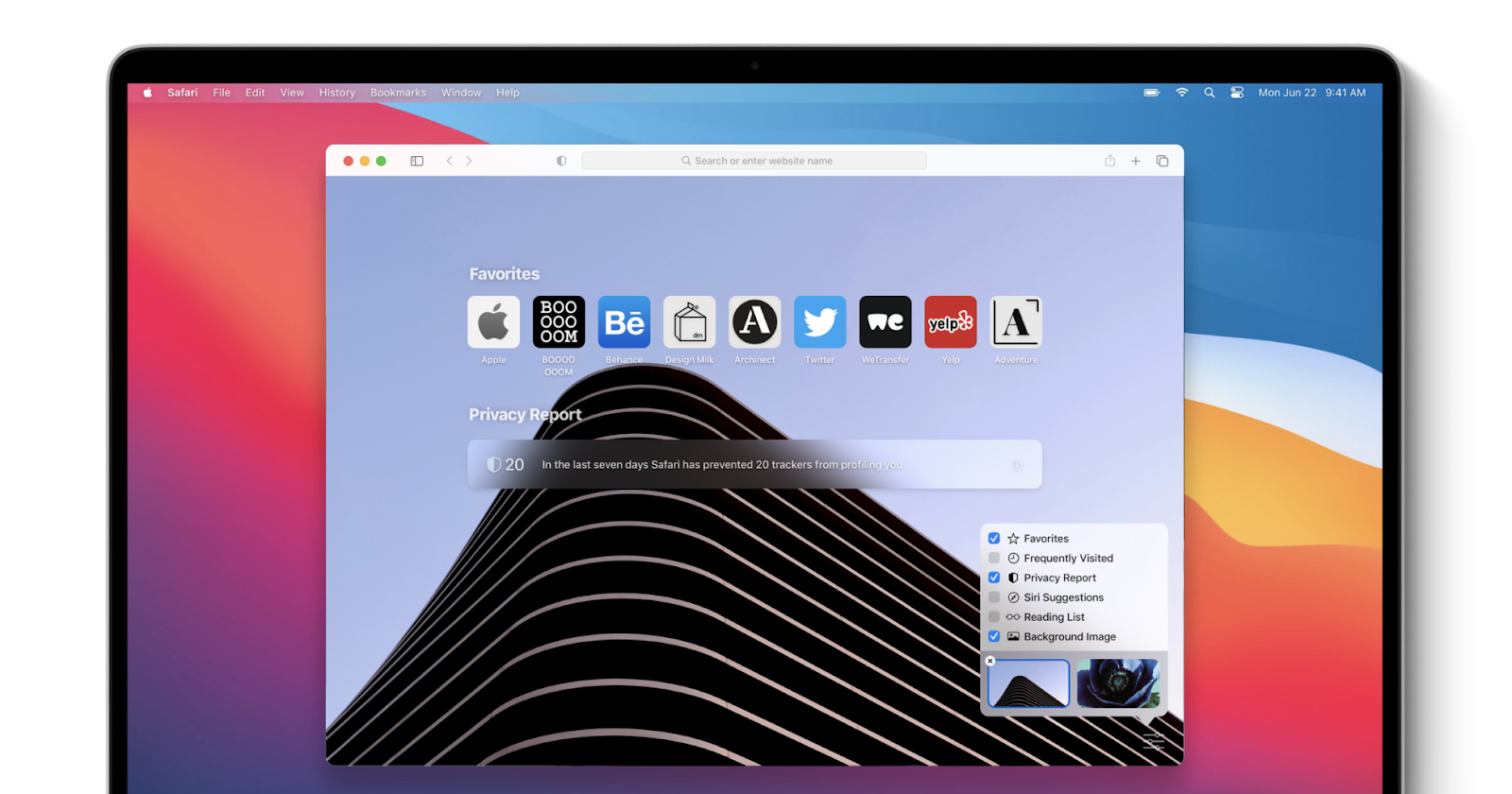
Another change coming along with MacOS Big Sur is that Safari will support a customizable start page.
Image credit: Apple
In addition to the Universal App Quick Start Program, SwiftUI is undergoing a major update to help developers adapt to the recent changes and new features. In the new OS, Mac Catalyst apps will automatically inherit the new look and capability to embrace new features.
MacOS Big Sur is intended to help bridge the gap between the old CPU and Apple Silicon as efficiently as possible. The design changes remain intuitive and will be second nature as the majority of the designs mimic functionality and behavior that we are familiar with from iOS and iPadOS. These similarities include uniformity in apps as well as general flow of notifications. As the developer, you can expect to see a much more unified OS across all Apple platforms.
Small, but exciting announcements
For the tech enthusiasts and Apple fanatics, some new bells and whistles were introduced with iOS14. Apple showed off mostly, and amongst other things, cosmetic changes and convenience features added to almost all in-house apps. Ranging from new Memoji to home screen widgets and custom email and web browser apps. Gmail + Chrome anyone?
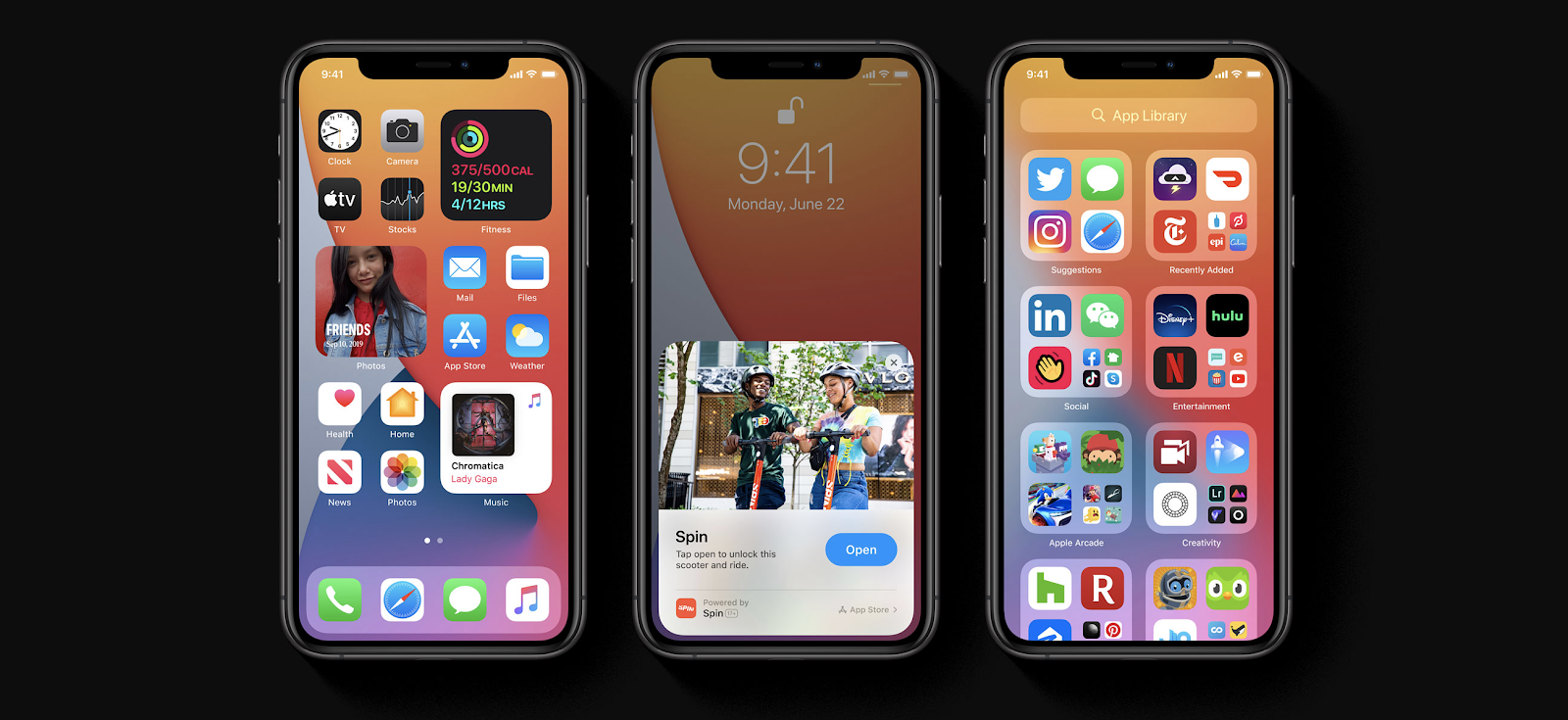
Depicted in the image is a preview of custom widgets (left), app clips (middle), and app library (right).
Image credit: Apple
App Library
In iOS14, one of the many updates includes the app library. The newly designed app library allows the user to organize apps in a new way. You are no longer confined to Apple’s default layout or arrangement of apps, and it’s far beyond categorizing apps in folders.
Widgets
You can pin widgets to the home screen based on your needs and most commonly used applications or features. These widgets can be moved around and resized, so that it can match the need of its function. Put the information you care about most, front and center.
WidgetKit
WidgetKit will enable developers to take advantage of the new widget feature for their own applications. As the developer, keep in mind that these widgets are not mini apps, they are meant to be used as a “glance” and not be interactive. Apple suggested that widgets be “glanceable, relevant, and personalized.” Widgets could be a great opportunity for developers to increase application exposure and increase engagement. Talk about growing a more loyal user base!
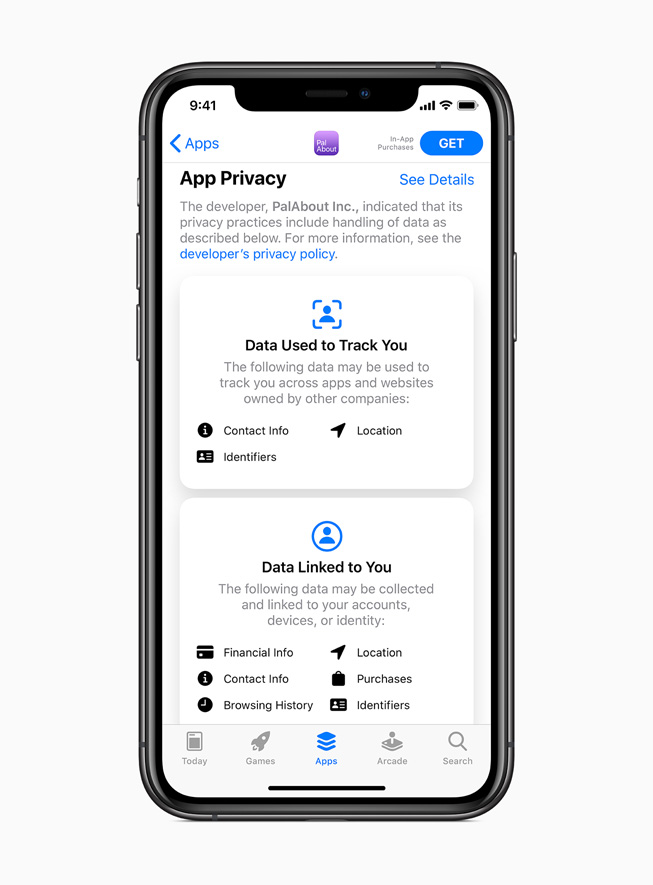
Depicted in the image is some of the new privacy features of iOS 14.
Image credit: Apple
Privacy Settings
In the app store itself, users will be able to see required privacy settings for apps as a pop up before downloading. This provides an opportunity for users to be more informed of particular app requirements and settings that he/she may otherwise be unaware of.
App Clips
The main trend seen in iOS14 is improved efficiency. App clips will allow the user to scan a QR code or NFC to access a particular feature in an app, without actually needing to download it. This is ideal for tasks that may only be performed once such as looking at a menu or signing up for a rewards program.
Picture in Picture Video
You can now watch videos while interacting with other apps with the help of picture in picture video. This will even work while on a phone call or FaceTime call. Additionally, if receiving a call, only a small notification will be displayed, rather than the whole screen being blocked out. You no longer have to stop everything you’re doing to let a phone call ring through and go to voicemail (without immediately declining the call).
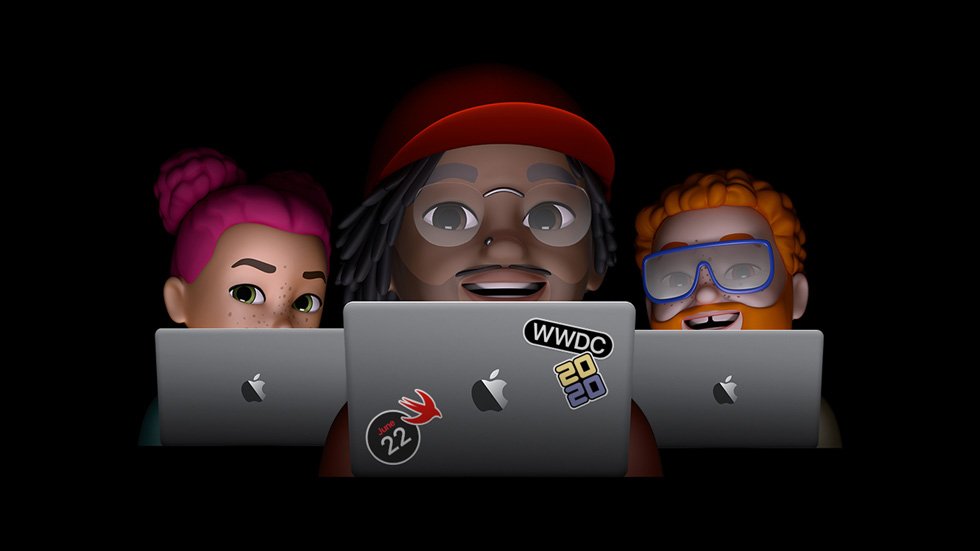
New memoji features to be included in iOS 14.
Image credit: Apple
Messaging
A handy messaging feature that was just introduced includes the ability to tag people in group chats as a mention. This allows users to set notifications to be turned on only when he/she is tagged in a chat, rather than each and every message. Prevent your phone from blowing up while your friends are planning the weekend BBQ get-together!
Memoji’s
Also in the messages department, there will be 20 new head and headwear options for memoji’s, one being a facemask. There will also be three new actions including giving a hug, sending a blush, and sending a fistbumb.
Unlock your car
For travel needs, the iPhone will leverage carplay to give users the ability to unlock and start their car from the comfort of their phone. Apple has partnered with BMW to pilot the new feature. This feature will allow users to share their digital key amongst friends and family. Say goodbye to clunky car keys.
Cycling and EV routes in Maps
For any die hard cyclists or commuters who get to work on a bike, Apple Maps has introduced an enhanced experience for cycling routes and directions. Identify the safest and most efficient bike path and get notified of any stairs or steep inclines that you may come across on the route.
Translate app
Another useful feature being released includes a translation app. This app is intended to operate in real time to translate various languages and will be ideal for exploration of foreign countries.
Thanks for reading!
In the coming years, the development world is bound to face huge changes. At Seamgen, we will be actively working to adapt to these changes and produce high quality software for all clients. To stay updated on other tech trends and updates, explore our other blog posts and subscribe to our newsletter. For more information, contact us today.








